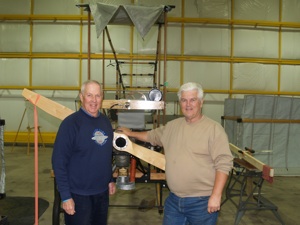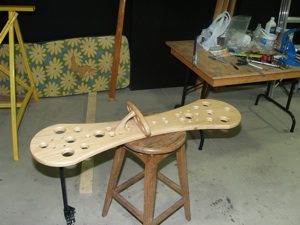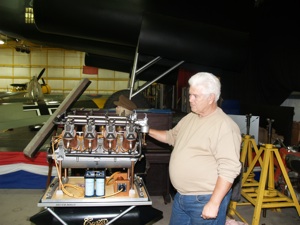
Features
History
Silver Dart replica to celebrate 100th anniversary of powered flight in Canada
 To commemorate the centenary of powered flight in Canada, a group of aviation enthusiasts in the Niagara Peninsula are building a replica of the Silver Dart, the first successful, controlled powered flight of an aircraft in Canada.
To commemorate the centenary of powered flight in Canada, a group of aviation enthusiasts in the Niagara Peninsula are building a replica of the Silver Dart, the first successful, controlled powered flight of an aircraft in Canada.
First flight on Feb. 6, 2009.
December 11, 2008 By Administrator
To commemorate the centenary of powered flight in Canada, a group of aviation enthusiasts in the Niagara Peninsula are building a replica of the Silver Dart, the first successful, controlled powered flight of an aircraft in Canada. That flight took place on Feb. 23, 1909. Circa 1909, a successful flight was defined as an aircraft taking off, attaining level flight and landing under its own power without mishap. Since Canada was, and is a member of The British Commonwealth, it was also the first successful powered flight in the British Commonwealth outside of the United Kingdom.
 |
|
| AEA 2005 members Gerald Haddon (left) and Doug Jermyn in front of Silver Dart replica during its construction. | |
 |
|
| One of the woodcrafters has built an exact copy of the actual seat, which is extremely uncomfortable. | |
 |
|
| Doug Jermyn with detailed replica of the original Curtiss engine, rigorously correct to the last millimetre. It looks so real it even feels like metal to the touch. |
In 1907, Alexander Graham Bell formed a syndicate of like-minded adventurers and with his wife's money, the group set about to explore the mysteries of powered flight. They called themselves the Aerial Experiment Association (AEA). It was an eclectic group, including three Americans – Alexander Graham Bell himself; Lieutenant Thomas Selfridge, an artillery officer in the American Army; and Glenn Curtiss, a famous motorcyclist. Two Canadians, J.A.D. McCurdy and Casey Baldwin, both recent mechanical engineering graduates, made up the rest of the AEA.
The Silver Dart was one of five aircraft built by the group and was first flown off lake Keuka, Hammondsport, N.Y. on Dec. 8, 1908. They dismantled the Silver Dart in January 1909 and moved it to Bell's summer home on Baddeck Bay, Bras d'Or Lake, N.S. There, on the cold afternoon of Feb. 23, 1909, from the frozen waters of the lake, J.A.D. McCurdy piloted the first successful flight of an aircraft capable of sustaining flight under its own power in Canada and the British Commonwealth.
Here in Niagara we formed the AEA 2005 and commenced work on a full-scale, flying replica of the Silver Dart, hopefully to be flown on the anniversary date of Feb. 23, 2009, from Baddeck Bay, N.S. We built the aircraft, from copies of the original drawings using as many of the original materials as possible. We have had to compromise a bit in that respect in order to comply with current safety standards. We have used bamboo for the fuselage and spruce for the wings, both products still being available. The original wing fabric is no longer produced so we have used contemporary sail material. Unfortunately the engine built by Glenn Curtiss, later to distinguish himself as a manufacturer of aero engines, was a hand built, one-off. After the AEA had completed their experiments on the Silver Dart, the engine was put to good use in a Nova Scotia fishing vessel, which eventually sank.
Many years later the engine was recovered and now rests with the Canadian Aviation Collection in Ottawa. It is doubtful that we could have persuaded the collection to attempt a re-build which in any case would have been far too costly for our project. We were lucky enough to have a 65-horsepower Lycoming aero engine donated to us and even luckier to have it rebuilt by another benefactor, Leavens Brothers of Toronto. One of our skilful artisans has built a detailed replica of the original engine, rigorously correct to the last millimetre. It looks so real it even feels like metal to the touch. Another of our woodcrafters has built exact copies of the control wheel and seat, which is extremely uncomfortable. The laminated, soft maple, propeller used for display will be shaped using a laser device guided by a CAD software program.
In order to ensure it is safe to fly we have added brakes, a more ergonomically designed seat and rudder pedals. When the flights are finished the Lycoming will be replaced by the replica Curtiss engine with the display prop and the copies of the original control wheel and seat will be re-installed. The rudder pedals and brakes will be removed and the Silver Dart will be placed in the Bell Museum at Baddeck.
Our pilot is Bjarni Trggvason, Canadian astronaut, aerobatic pilot and professor of aerodynamics at the University of Western Ontario. Bjarni’s credentials, degrees and awards, like the rest of our Canadian astronauts, are too numerous to list here. Using the original drawings and a CAD design technique known as stereo lithography, Bjarni has been able to construct a model to verify the aerodynamics of the Silver Dart’s flying surfaces in the wind tunnel at the University of Western Ontario.
All the work, except rebuilding the donated Lycoming engine, has been done by volunteers. We have received funding from the Ontario Trillium Foundation, which gets its revenue from provincial lotteries, Pratt and Whitney Canada, Leavens Brothers Toronto, Bombardier, The Air Force Association of Canada, and our own pockets. Additionally, we have received discounts from others towards the purchase of certain materials needed for the project. The Russell Aviation Group (RAG) has graciously donated space in their hangar for the final assembly of the Silver Dart. It is quite an honour to be a stable mate of such other historic thoroughbreds as a Spitfire, a Hurricane, a Messerschmitt 109 and a magnificent example of the most prolific trainer of the allies in the Second World War, a snarling Harvard.
The second phase of the project involves promoting aviation, or, more specifically, the history of Canadian aviation to schoolchildren from Junior Kindergarten to Grade 8. Members of our association have visited nearly 300 classes in the Niagara peninsula over a four-year period. We were met with enthusiasm and respect by all staff and students, and it was both rewarding and gratifying to those involved to note how keenly interested and hungry present day children are for Canadian history and how respectful they were of us older folks.
The CBC, has already filmed our work in progress, will cover our test flights and, of course, the re-enactment of the historic event, for inclusion in a documentary celebrating 100 years of powered flight in Canada.
As a former airline pilot I’m proud to have been part of this group of dedicated aviation aficionados.
Jim Griffith
Member Board of Directors
AEA 2005
For more on information on the Welland Group, see the excellent article
written by Gerald Haddon on The Vintage Wings of Canada website at
http://www.vintagewings.ca/page?s=63&lang=en-CA and visit www.silverdartreplica.com .